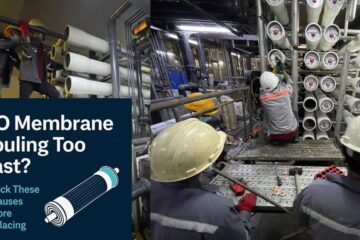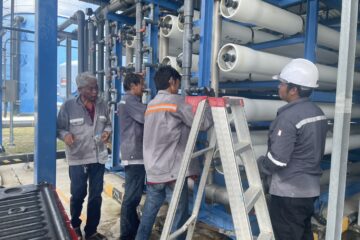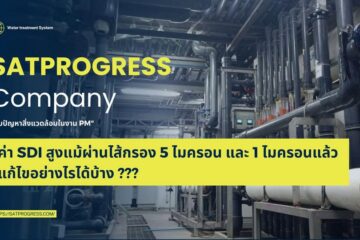Addressing Rapid Membrane Fouling in Reverse Osmosis Systems: Insights from Research
Reverse Osmosis (RO) membranes are crucial components in water purification systems, effectively removing contaminants to produce high-quality water. However, one of the most significant challenges faced in RO systems is membrane fouling. Rapid fouling can lead to reduced efficiency, increased operational costs, and shortened membrane lifespan. This article explores the causes of rapid membrane fouling and provides evidence-based strategies to address and mitigate this issue.

Understanding Membrane Fouling
Membrane fouling occurs when substances from the feed water accumulate on or within the membrane, obstructing its pores and degrading its performance. Fouling can be categorized into several types, including:
- Organic Fouling: Caused by the accumulation of organic materials such as proteins, humic substances, and polysaccharides.
- Inorganic Fouling: Results from the precipitation of salts and scaling compounds like calcium carbonate and calcium sulfate.
- Biological Fouling: Due to the growth of microorganisms, including bacteria and algae, on the membrane surface.
- Colloidal Fouling: Involves the deposition of suspended particles and colloids.
Causes of Rapid Membrane Fouling
Several factors contribute to the rapid fouling of RO membranes:
- Feed Water Quality: High concentrations of organic matter, suspended solids, and microorganisms can accelerate fouling. For instance, water with high Total Organic Carbon (TOC) levels is more prone to organic fouling.
- Operational Conditions: High operating pressures, temperatures, and flux rates can exacerbate fouling. Studies have shown that excessive flux can lead to higher fouling rates due to increased shear stress and concentration polarization.
- Chemical Imbalance: The presence of scaling-forming compounds like calcium carbonate in feed water can lead to inorganic fouling if not managed properly.
- Membrane Properties: The choice of membrane material and its surface characteristics influence fouling resistance. Membranes with lower hydrophilicity or inadequate surface modification may be more susceptible to fouling.
Strategies to Mitigate Rapid Membrane Fouling
Based on research and industry practices, several strategies can be employed to address and mitigate rapid membrane fouling:
- Pre-Treatment Optimization: Proper pre-treatment of feed water is crucial. This includes using filtration systems to remove large particles and organic matter before it reaches the RO membrane. Implementing coagulation-flocculation and sedimentation processes can effectively reduce fouling potential.
- Chemical Cleaning: Regular chemical cleaning of the membrane is essential to remove fouling deposits. Common cleaning agents include acids for inorganic fouling (e.g., hydrochloric acid for calcium carbonate) and alkaline solutions for organic fouling (e.g., sodium hydroxide). Cleaning protocols should be optimized based on the type of fouling and membrane material.
- Membrane Modification: Advances in membrane technology include surface modifications to enhance hydrophilicity and reduce fouling. For example, hydrophilic coatings and grafting techniques have been shown to improve fouling resistance.
- Flux Management: Adjusting the operational flux and pressure to optimal levels can help in managing fouling. Lowering the flux rate and operating pressure can reduce the rate of fouling and extend membrane life.
- Monitoring and Control: Implementing real-time monitoring systems to track key parameters such as pressure, flow rates, and water quality can help in early detection of fouling issues. Automated control systems can adjust operational conditions dynamically to prevent excessive fouling.
Conclusion
Rapid membrane fouling is a significant challenge in RO systems that can affect performance and operational efficiency. Understanding the causes of fouling and implementing effective mitigation strategies is essential for maintaining optimal membrane function. By optimizing feed water pre-treatment, employing regular chemical cleaning, utilizing advanced membrane technologies, managing flux rates, and incorporating real-time monitoring, operators can effectively address and reduce the impact of membrane fouling.
การจัดการกับการอุดตันของเมมเบรนในระบบ Reverse Osmosis
การอุดตันของเมมเบรน (membrane fouling) เป็นปัญหาสำคัญที่ส่งผลกระทบต่อประสิทธิภาพของระบบ Reverse Osmosis (RO) ซึ่งสามารถทำให้ประสิทธิภาพการกรองลดลง เพิ่มต้นทุนการดำเนินงาน และลดอายุการใช้งานของเมมเบรน การอุดตันที่รวดเร็วเป็นปัญหาที่พบได้บ่อยและสามารถทำให้ระบบ RO มีประสิทธิภาพต่ำลง บทความนี้จะสำรวจสาเหตุของการอุดตันอย่างรวดเร็วและเสนอวิธีการที่ใช้ข้อมูลจากงานวิจัยในการจัดการและลดปัญหานี้
การทำความเข้าใจการอุดตันของเมมเบรน
การอุดตันของเมมเบรนเกิดขึ้นเมื่อสารต่าง ๆ จากน้ำป้อนสะสมบนหรือลึกเข้าไปในเมมเบรน ทำให้รูพรุนของเมมเบรนถูกปิดกั้นและลดประสิทธิภาพของการกรอง การอุดตันสามารถแบ่งออกเป็นประเภทต่าง ๆ ได้ดังนี้
- การอุดตันจากสารอินทรีย์: เกิดจากการสะสมของสารอินทรีย์ เช่น โปรตีน สารฮิวมิก และพอลิแซคคาไรด์
- การอุดตันจากสารอนินทรีย์: เกิดจากการตกตะกอนของเกลือและสารที่เป็นสเกล เช่น แคลเซียมคาร์บอเนตและแคลเซียมซัลเฟต
- การอุดตันจากชีวภาพ: เกิดจากการเจริญเติบโตของจุลชีพ รวมถึงแบคทีเรียและสาหร่ายบนพื้นผิวของเมมเบรน
- การอุดตันจากสารโคลอยด์: เกี่ยวข้องกับการตกตะกอนของอนุภาคที่ลอยอยู่และโคลอยด์
สาเหตุของการอุดตันของเมมเบรนอย่างรวดเร็ว
หลายปัจจัยสามารถทำให้การอุดตันของเมมเบรนเกิดขึ้นได้อย่างรวดเร็ว
- คุณภาพของน้ำป้อน: ความเข้มข้นสูงของสารอินทรีย์ อนุภาคแขวนลอย และจุลชีพสามารถทำให้เกิดการอุดตันได้เร็วขึ้น เช่น น้ำที่มีระดับ Total Organic Carbon (TOC) สูงมักมีแนวโน้มที่จะเกิดการอุดตันจากสารอินทรีย์
- เงื่อนไขการทำงาน: ความดันที่สูง อุณหภูมิ และอัตราการไหลที่สูงเกินไปสามารถเพิ่มอัตราการอุดตัน การศึกษาแสดงให้เห็นว่าการเพิ่มอัตราการไหลเกินไปสามารถทำให้เกิดการอุดตันได้เร็วขึ้นเนื่องจากความเครียดจากการเฉือนและการสะสมของความเข้มข้น
- ความไม่สมดุลของสารเคมี: การมีสารประกอบที่ก่อให้เกิดการสร้างสเกล เช่น แคลเซียมคาร์บอเนตในน้ำป้อนอาจทำให้เกิดการอุดตันจากสารอนินทรีย์หากไม่ได้รับการจัดการอย่างเหมาะสม
- คุณสมบัติของเมมเบรน: การเลือกวัสดุเมมเบรนและลักษณะผิวของเมมเบรนมีอิทธิพลต่อความต้านทานต่อการอุดตัน เมมเบรนที่มีความไฮดรอฟิลิกต่ำหรือการดัดแปลงผิวที่ไม่เหมาะสมอาจมีแนวโน้มที่จะเกิดการอุดตันได้มากขึ้น
กลยุทธ์ในการจัดการกับการอุดตันของเมมเบรน
ตามงานวิจัยและการปฏิบัติในอุตสาหกรรม มีหลายกลยุทธ์ที่สามารถใช้เพื่อจัดการและลดการอุดตันของเมมเบรนอย่างรวดเร็ว:
- การบำบัดน้ำป้อนล่วงหน้า : การบำบัดน้ำป้อนอย่างเหมาะสมเป็นสิ่งสำคัญ ซึ่งรวมถึงการใช้ระบบกรองเพื่อกำจัดอนุภาคขนาดใหญ่และสารอินทรีย์ก่อนที่จะถึงเมมเบรน RO การใช้กระบวนการรวมถึงการเกาะกลุ่มและการตกตะกอนสามารถลดแนวโน้มการอุดตันได้อย่างมีประสิทธิภาพ
- การทำความสะอาดด้วยสารเคมี: การทำความสะอาดด้วยสารเคมีอย่างสม่ำเสมอของเมมเบรนเป็นสิ่งสำคัญในการกำจัดตะกอนที่เกิดจากการอุดตัน สารทำความสะอาดทั่วไป ได้แก่ กรดสำหรับการอุดตันจากสารอนินทรีย์ (เช่น กรดไฮโดรคลอริกสำหรับแคลเซียมคาร์บอเนต) และสารละลายด่างสำหรับการอุดตันจากสารอินทรีย์ (เช่น โซเดียมไฮดรอกไซด์) ควรมีการปรับการทำความสะอาดให้เหมาะสมตามประเภทของการอุดตันและวัสดุเมมเบรน
- การปรับเปลี่ยนเมมเบรน : ความก้าวหน้าในเทคโนโลยีเมมเบรนรวมถึงการดัดแปลงพื้นผิวเพื่อเพิ่มความไฮดรอฟิลิกและลดการอุดตัน การเคลือบไฮดรอฟิลิกและเทคนิคการฝังสารเคลือบได้แสดงให้เห็นว่าสามารถปรับปรุงความต้านทานต่อการอุดตัน
- การจัดการอัตราการไหล: การปรับอัตราการไหลและความดันให้เหมาะสมสามารถช่วยในการจัดการกับการอุดตัน การลดอัตราการไหลและความดันสามารถลดอัตราการอุดตันและขยายอายุการใช้งานของเมมเบรน
- การติดตามและควบคุม: การติดตั้งระบบติดตามในเวลาจริงเพื่อติดตามพารามิเตอร์สำคัญ เช่น ความดัน อัตราการไหล และคุณภาพน้ำสามารถช่วยในการตรวจจับปัญหาการอุดตันได้เร็วขึ้น ระบบควบคุมอัตโนมัติสามารถปรับเงื่อนไขการทำงานโดยอัตโนมัติเพื่อลดการอุดตันเกิน
สรุป
การอุดตันของเมมเบรนที่รวดเร็วเป็นปัญหาที่สำคัญในระบบ RO ซึ่งสามารถส่งผลกระทบต่อประสิทธิภาพและประสิทธิผลการดำเนินงาน การเข้าใจสาเหตุของการอุดตันและการใช้กลยุทธ์การจัดการที่มีประสิทธิภาพเป็นสิ่งสำคัญในการรักษาฟังก์ชันของเมมเบรนให้ดีที่สุด โดยการปรับปรุงการบำบัดน้ำป้อน การทำความสะอาดด้วยสารเคมี การใช้เทคโนโลยีเมมเบรนที่ก้าวหน้า การจัดการอัตราการไหล และการติดตามในเวลาจริง ผู้ปฏิบัติงานสามารถจัดการและลดผลกระทบของการอุดตันของเมมเบรนได้อย่างมีประสิทธิภาพ
GET IN TOUCH



0 Comments